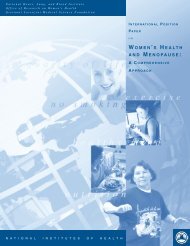HeartsNParks Community Mobilization Guide - National Heart, Lung ...
HeartsNParks Community Mobilization Guide - National Heart, Lung ...
HeartsNParks Community Mobilization Guide - National Heart, Lung ...
You also want an ePaper? Increase the reach of your titles
YUMPU automatically turns print PDFs into web optimized ePapers that Google loves.
The <strong>Heart</strong>-Healthy<br />
Eating Plan<br />
The foods you eat<br />
play a big part in<br />
keeping your heart<br />
healthy. But, what<br />
exactly is a hearthealthy<br />
eating plan?<br />
And is a heart-healthy<br />
eating plan important for<br />
everyone? All healthy Americans,<br />
2 years of age or older, should<br />
eat in a way that is lower in<br />
total fat, saturated fat, cholesterol,<br />
sodium, and extra calories.<br />
<strong>Heart</strong> disease is still the number one killer of<br />
both men and women in the United States.<br />
High blood cholesterol, high blood pressure,<br />
smoking, overweight, and physical inactivity<br />
increase your risk of getting heart disease. The<br />
good news is that you can change these risk<br />
factors and reduce your risk of heart disease.<br />
In order to help your family eat in a hearthealthy<br />
way, follow these recommendations.<br />
1 Choose foods low in saturated fat.<br />
All foods that contain fat are made up of a<br />
mixture of saturated and unsaturated fats.<br />
Saturated fat raises your blood cholesterol<br />
level more than anything else you eat. The<br />
best way to reduce blood cholesterol is to<br />
choose foods lower in saturated fat. Less<br />
than 10 percent of the calories in your diet<br />
should come from saturated fat. One way to<br />
help your family do this is by choosing<br />
foods such as fruits, vegetables, and whole<br />
grains—foods naturally low in total fat and<br />
high in starch and fiber.<br />
2 Choose foods low in total fat.<br />
Since many foods high in total fat are also<br />
high in saturated fat, eating foods low in<br />
total fat will help your family<br />
eat less saturated fat. No more<br />
than 30 percent of the calories<br />
in your diet should come from<br />
fat. When you do eat fat,<br />
substitute unsaturated fat—<br />
either polyunsaturated or<br />
monounsaturated—for<br />
saturated fat. But, watch the<br />
amount. Fat is a rich source of<br />
calories, so eating foods low in fat<br />
will also help you eat fewer calories.<br />
Eating fewer calories can help you<br />
lose weight and, if you are overweight, losing<br />
weight is an important part of lowering your<br />
blood cholesterol.<br />
3 Choose foods high in starch and fiber.<br />
Foods high in starch and fiber are excellent<br />
substitutes for foods high in saturated fat.<br />
These foods—breads, cereals, pasta, grains,<br />
fruits, and vegetables—are low in saturated<br />
fat and cholesterol. They are also lower in<br />
calories than foods that are high in fat. But<br />
limit fatty toppings and spreads like butter<br />
and sauces made with cream and whole<br />
milk dairy products. Foods high in starch<br />
and fiber are also good sources of vitamins<br />
and minerals.<br />
When eaten as part of a diet low in saturated<br />
fat and cholesterol, foods with soluble<br />
fiber—like oat and barley bran and dry<br />
peas and beans—may help to lower blood<br />
cholesterol.<br />
4 Choose foods low in cholesterol.<br />
Remember, dietary cholesterol can raise<br />
blood cholesterol, although usually not as<br />
much as saturated fat. So it’s important for<br />
your family to choose foods low in dietary<br />
Healthy Eating 29
















